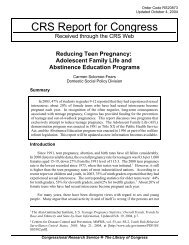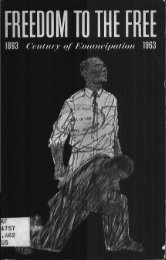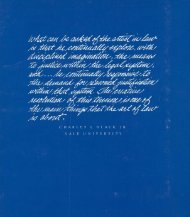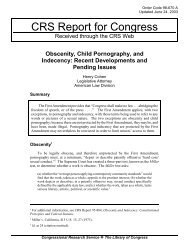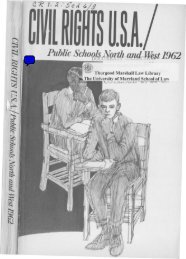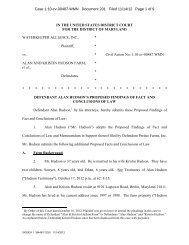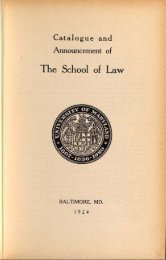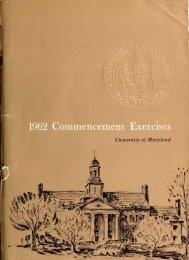journal - University of Maryland School of Law
journal - University of Maryland School of Law
journal - University of Maryland School of Law
You also want an ePaper? Increase the reach of your titles
YUMPU automatically turns print PDFs into web optimized ePapers that Google loves.
40 MD. JOURNAL OF INTERNATIONAL LAW & TRADE [Vol. 14<br />
competition with their products."' 24<br />
IV.<br />
By allowing the exception for commonly controlled or owned companies<br />
to stand, one majority <strong>of</strong> the Supreme Court encourages international<br />
competition and free trade across borders. Without the protection<br />
<strong>of</strong> § 526, some companies will not receive a monopoly in the sale <strong>of</strong><br />
trademarked goods in the United States which could be used to fix<br />
higher prices for American consumers. Whatever harm the United<br />
States owners <strong>of</strong> trademarks may claim due to the Court's holding can<br />
be mitigated by alternatives to § 526 such as various statutes and tort<br />
theories.<br />
The second majority in K Mart struck down the authorized use<br />
exception to § 526. The effect <strong>of</strong> this holding is to protect American<br />
businessmen from competition in the American companies' own trademarked<br />
goods. The same activity <strong>of</strong> a gray market importer, if done by<br />
a domestic firm authorized to use a trademark for manufacturing,<br />
would constitute a trademark infringement. The Supreme Court has<br />
simply provided analogous protection in the case <strong>of</strong> a foreign manufacturer<br />
authorized to use the trademark. Additionally, this majority prevents<br />
a gray market importer from being unjustly enriched by the<br />
American trademark holder's advertising expenses, good will, and entrepreneurial<br />
skill. Protecting the exclusive rights <strong>of</strong> an owner <strong>of</strong> a<br />
United States trademark also benefits American consumers by giving<br />
them the assurance that the trademarked goods they purchase have a<br />
consistent source and quality. This protection, however, if abused, is<br />
limited by antitrust and contract law.<br />
The approaches <strong>of</strong> the two majorities, in terms <strong>of</strong> trade policy and<br />
the effect on international commerce, are inconsistent. The Court's<br />
overall holding, however, is consistent with modern statutory construction<br />
jurisprudence. 125 Perhaps the actual disagreement between the two<br />
majorities goes not to ambiguities and statutory construction so much<br />
as to where the line should be drawn between international free trade<br />
on one side, and protection <strong>of</strong> American business investments on the<br />
other. 126 If this is true, the Court's compromise, even though difficult to<br />
124. Id. at 235.<br />
125. See K Mart Corp. v. Cartier, 486 U.S. 281, 284 (1988) (Part II A <strong>of</strong> Justice<br />
Kennedy's majority opinion discusses the standard <strong>of</strong> review for agency regulations and<br />
supra notes 62-63 and text).<br />
126. This conclusion is supported by the fact that Justice Kennedy's terse opinion<br />
for the majorities, focusing only on the language and intent <strong>of</strong> the statute and regula-



